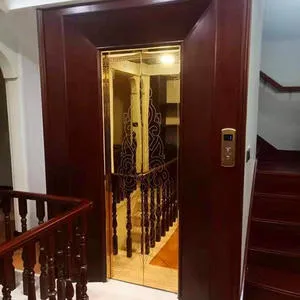 English
English Español
Español Português
Português русский
русский français
français 日本語
日本語 Deutsch
Deutsch Tiếng Việt
Tiếng Việt Italiano
Italiano Nederlands
Nederlands ไทย
ไทย Polski
Polski 한국어
한국어 Svenska
Svenska magyar
magyar Malay
Malay বাংলা
বাংলা Dansk
Dansk हिन्दी
हिन्दी Pilipino
Pilipino Türk
Türk Gaeilge
Gaeilge عربى
عربى Indonesia
Indonesia norsk
norsk čeština
čeština Ελληνικά
Ελληνικά Українська
Українська Javanese
Javanese فارسی
فارسی नेपाली
नेपाली Burmese
Burmese ລາວ
ລາວ Latine
Latine Қазақ
Қазақ Euskal
Euskal Македонски
Македонски Lietuvos
Lietuvos Eesti Keel
Eesti Keel Română
Română Српски
Српски Afrikaans
Afrikaans Bosanski
Bosanski Кыргыз тили
Кыргыз тили Maori
Maori Монгол хэл
Монгол хэл IsiXhosa
IsiXhosa Точик
Точик O'zbek
O'zbek Lëtzebuergesch
Lëtzebuergesch
Square vs Round Elevators: A New Era in Elevator Design
2024/06/17
In the world of architecture and building design, elevators are not just functional elements but integral components that contribute to the aesthetic and practical value of a structure. Recently, there has been a growing interest in exploring unconventional elevator designs, particularly square and round elevators. Both types bring unique benefits and challenges, and their adoption is reshaping the landscape of modern architecture.

Square Elevators: The Classic Choice
Square elevators have long been the standard in residential and commercial buildings. Their popularity stems from several key advantages:
1. Space Efficiency: Square elevators are easier to integrate into building layouts, particularly in spaces with right angles. They can maximize available space, providing ample room for passengers and cargo.
2. Ease of Installation: Square elevators are typically easier and faster to install due to their straightforward design. This can lead to cost savings in construction and maintenance.
3. Versatility: These elevators are versatile, fitting seamlessly into a variety of architectural styles, from traditional to modern. They are also more adaptable to different sizes and capacities, making them suitable for various buildings.
Despite these advantages, square elevators are not without their limitations. Their conventional shape may sometimes limit creative architectural expressions and might not always provide the best solution for buildings with unique design requirements.

Round Elevators: The Modern Twist
Round elevators, on the other hand, are gaining traction for their futuristic appeal and distinctive characteristics:
1. Aesthetic Appeal: Round elevators offer a sleek and modern look that can enhance the visual appeal of any building. They are often used in high-end residential complexes, hotels, and corporate offices to create a statement of luxury and innovation.
2. Panoramic Views: Many round elevators feature glass walls, providing panoramic views that can transform the elevator ride into a memorable experience. This feature is particularly attractive in scenic locations or high-rise buildings with stunning vistas.
3. Innovative Design: The circular shape of round elevators allows for innovative placement within a building. They can be used as central features in atriums or as exterior lifts, adding a dynamic element to the building's design.
However, round elevators also come with challenges. Their installation can be more complex and expensive, requiring specialized construction techniques and materials. Additionally, they may not be as space-efficient as square elevators, particularly in buildings with limited floor space.
Choosing the Right Elevator for Your Building
When deciding between square and round elevators, several factors need to be considered:
1. Building Design: The overall design and layout of the building will significantly influence the choice of elevator. Square elevators are ideal for traditional, space-efficient designs, while round elevators are suited for modern, aesthetically-driven projects.
2. Budget: Budget constraints play a crucial role. Square elevators generally offer a more cost-effective solution, while round elevators may require a higher investment due to their complex installation and materials.
3. Purpose and Usage: The intended use of the elevator also matters. For example, buildings that prioritize functionality and efficiency, such as office buildings and hospitals, might prefer square elevators. In contrast, buildings that aim to provide a unique and luxurious experience, such as hotels and high-end residential buildings, might opt for round elevators.
In conclusion, the choice between square and round elevators is not just about functionality but also about enhancing the architectural and aesthetic value of a building. As architects and designers continue to push the boundaries of innovation, the adoption of diverse elevator designs will likely grow. Whether it’s the classic practicality of square elevators or the modern allure of round elevators, both types are set to play a significant role in the future of building design.




